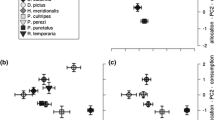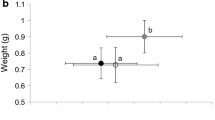Summary
This study investigated the proximate basis of bimodally-distributed, environmentally-induced variation that occurs in natural populations of spade-foot toad tadpoles (Scaphiopus multiplicatus). Most individuals in most populations occur as a small, slowly-developing omnivore morph. In some of these same populations, a varying number of individuals occur as a large, rapidly-developing carnivore morph (Pfennig 1989). Censuses of 37 different natural ponds revealed that the frequency of the faster-developing carnivore morph correlated significantly positively with fairy shrimp density (their chief prey) and pond drying rate. By simultaneously varying two diet components and pond drying regime in artificial pools I found that only fairy shrimp density significantly affected the proportion of carnivores. Separate experiments established that the extent to which tadpoles developed the carnivore morphology correlated with shrimp density, and that morph determination depended on the ingestion of shrimp, not simply their presence. If a critical number of shrimp were ingested, the tadpole developed into a carnivore; if not, the tadpole developed by default into an omnivore. Thus a single cue — shrimp ingestion — triggers alternative ontogenetic trajectories. Using shrimp density to induce morph differentiation enables tadpoles to respond to their environment adaptively as shrimp are most abundant in highly ephemeral ponds, where the faster developing carnivores are favored.
Similar content being viewed by others
References
Altig R (1970) A key to the tadpoles of the continental United States and Canada. Herpetologica 26:180–207
Bernays EA (1986) Diet-induced head allometry among foliage-chewing insects and its importance for graminivores. Science 231:495–497
Bradshaw AD (1965) Evolutionary significance of phenotypic plasticity in plants Adv Genet 13:115–155
Bragg AN (1965) Gnomes of the night: the spadefoot toads. Univ Pennsylvania Press, Philadelphia
Burton J (1972) Animals of the african year. The ecology of east Africa. Peter Lowe, The Netherlands
Cei JM (1969) The Patagonian telmatobiid fauna of the volcanic Somuncura Plateau of Argentina. J Herpet 3:1–18
Cochran WG, Cox GM (1957) Experimental design. John Wiley, New York
Collins JP, Cheek JE (1983) Effect of food and density on development of typical and cannibalistic salamander larvae in Ambystoma tigrinum nebulosum. Am Zool 23:77–84
Crowl TA, Covich AP (1990) Predator-induced life-history shifts in a freshwater snail. Science 247:949–951
Crump ML (1989) Effect of habitat drying on developmental time and size at metamorphosis in Hyla pseudopuma. Copeia 1989:794–797
Gilbert JJ, Stemberger RS (1984) Asplancha-induced polymorphism in the rotifer Keratella slacki. Limnol Oceanogr 26:1309–1316
Gosner KL (1960) A simplified table for staging anuran embryos and larvae with notes on identification. Herpetologica 16:183–190
Grant JWG, Bayly (1981) Predator induction of crests in morphs of the Daphnia carinata King complex. Limnol Oceanogr 26:201–218
Greene E (1989) A diet-induced developmental polymorphism in a caterpillar. Science 243:643–646
Hanken J (1983) Miniaturization and its effects on cranial morphology in plethodon salamanders, genus Thorius (Amphibia, Plethodontidae): II. The fate of the brain and sense organs and their role in skull morphogenesis and evolution. J Morphol 177:255–268
Harvell CD (1984) Predator-induced defense in a marine bryozoan. Science 224:1357–1359
Janzen DH (1984) Weather-related color polymorphism of Rothscildia lebeau (Saturniidae). Bull Ent Soc Am 30:16–20
Kennedy JS (1956) Phase transformation in locust biology. Biol Rev 31:349–370
Kornfield I, Taylor JN (1983) A new species of polymorphic fish, Cichlasoma minckleyi, from Cuatro Ciénegas, Mexico (Teleostei: Cichlidae). Proc Biol Soc Wash 96:253–269
Levene H (1953) Genetic equilibrium when more than one ecological niche is available. Am Nat 87:331–333
Levins R (1968) Evolution in changing environments. Princeton Univ Press, Princeton, NJ
Lively CM (1986a) Canalization versus developmental conversion in a spatially variable environment. Am Nat 128:561–572
Lively CM (1986b) Competition, comparative life histories, and maintenance of shell dimorphism in a barnacle. Ecology 67:858–864
Lloyd DG (1984) Variation strategies of plants in heterogeneous environments. Biol J of the Linn Soc 21:357–385
Loring SJ, MacKay WP, Whitford WG (1988) Ecology of desert playas. In: Thames JL, Ziebell CD (eds) Small water impoundments in semi-arid regions. Univ of New Mexico Press, Albuquerque, NM, pp 89–113
Mayr E (1963) Animal species and evolution. Harvard Univ Press, Cambridge, MA
Meyer A (1987) Phenotypic plasticity and heterochrony in Cichlasoma managuense (Pices, Cichlidae) and their implications for speciation in the cichlid fishes. Evolution 41:1357–1369
Moore WJ (1965) Masticatory function and skull growth. J Zool 146:123–131
Newman RA (1987) Effects of density and predation on Scaphiopus couchii tadpoles in desert ponds. Oecologia 71:301–307
Newman RA (1988) Adaptive plasticity in development of Scaphiopus couchii tadpoles in desert ponds. Evolution 774–783
Orton GL (1954) Dimorphism in larval mouthparts in spadefoot toads of the Scaphiopus hammondi Group. Copeia 1954:97–100
Pfennig DW (1989) Evolution, development, and behavior of alternative amphibian morphologies. PhD Diss, Univ of Texas, Austin
Pfennig DW, Mabry A, Orange D (1990) Causes and consequences of environmentally-induced covariance between age and size at metamorphosis in anurans. Ecology (in press)
Pomeroy LV (1981) Developmental polymorphism in the tadpoles of the spadefoot toad Scaphiopus multiplicatus. PhD Diss, Univ of California, Riverside
Raff RA, Kaufman TC (1983) Embryos, genes, and evolution. Macmillan New York
Roff DA (1986) The evolution of wing dimorphism in insects. Evolution 40:1009–1020
Semlitsch RD (1987) Paedomorphosis in Ambystoma talpoideum: Effects of density, food, and pond drying. Ecology 68:994–1002
Simovich MA (1985) Analysis of a hybrid zone between the spadefoot toads Scaphiopus multiplicatus and Scaphiopus bombifrons. PhD Diss. Univ of California, Riverside
Simovich MA, Sassaman CA (1986) Four independent electrophoretic markers in spadefoot toads. J Hered 77:410–414
Shapiro AM (1976) Seasonal polyphenism. Evol Biol 9:259–333
Sokal RR, Rohlf FJ (1981) Biometry, WH Freeman, San Francisco, CA
Sokol A (1984) Plasticity in the fine timing of metamorphosis in tadpoles of the hylid frog. Litoria ewingi. Copeia 1984:868–873
Stearns SC (1982) The role of development in the evolution of life histories. In: Bonner JT (ed) Evolution and development. Springer-Verlag, New York, pp 237–258
White BA, Nicoll CS (1981) Hormonal control of amphibian metamorphosis. In: Gilbert LI, Frieden E (eds) Metamorphosis. Plenum Press, New York, pp 363–396
Author information
Authors and Affiliations
Rights and permissions
About this article
Cite this article
Pfennig, D. The adaptive significance of an environmentally-cued developmental switch in an anuran tadpole. Oecologia 85, 101–107 (1990). https://doi.org/10.1007/BF00317349
Received:
Accepted:
Issue Date:
DOI: https://doi.org/10.1007/BF00317349




